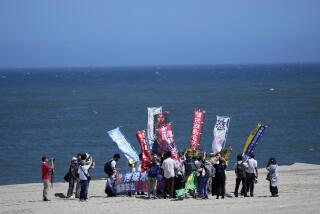Fallout From Nuclear Tests in Pacific
- Share via
I waited with French military officials for the countdown. But no grinning genie formed in the sky. No thunder betrayed the unleashed inferno below. Instead, the blue lagoon turned briefly white, and then a column of ocean burst 200 feet in the air. A moment later, the horizon seemed to shake. In the coral seas off Mururoa in French Polynesia, I had witnessed the awesome display of an underground nuclear explosion.
Here, in the world’s fabled image of paradise, the economy of nuclear weapons artificially subsidizes the economy at a critical time, when the center of geopolitical gravity is shifting toward the Pacific. This upheaval is due to a number of factors: The swelling human populations of China, Japan and Indonesia; a convergent American movement toward California; Mexico’s demographic explosion; the extraordinary technological and economic development of Japan, Korea, Malaysia and the American West Coast, and the emergence of Australia and New Zealand among the ranks of expanding powers.
In this cauldron boil new ambitions of all kinds. The vast watery domain of the South Pacific contains countless islands and atolls of insignificant resources, thinly populated by Micronesians, Melanesians, and Polynesians. These islands have nothing to offer the great powers other than to serve as strategic support, more or less camouflaged military bases.
The United States used to test nuclear bombs at Bikini and Eniwetok. The French have used Mururoa since 1956, switching from atmospheric to underground tests in 1975. Bombs are fed into shafts drilled into the atoll’s volcanic core and then detonated.
In 1987, I received permission from the French Ministry of Defense to observe an explosion at Mururoa and afterward sample the seas and its sediment for radioactivity. We were not permitted to sample areas contaminated by the atmospheric detonations carried out before 1975.
To remain independent from the French Atomic Authority, Calypso commissioned the Institute of Marine Biogeological Chemistry of the Ecole Normale Superieure of Paris. Our results, recently released, showed the waters of the lagoon had negligible traces of radioactive elements, mainly cesium. One plankton sample showed contamination by iodine 131 at levels similar to those found in the Mediterranean a month after the Chernobyl explosion; French officials attributed this to a leak during a post-drilling check made a few weeks before the test.
Geiger counter tests turned up no detectable traces of radioactivity underwater, but in a few areas of the outer reef the coral cliffs had collapsed and some fissures in the atoll extended down at least 600 feet, and further, beyond our reach.
Of course I know that no explosions take place in coral rocks, but all are tested in hard volcanic basalt, the core around which the corals have grown. No evidence exists of any leak through basalt. But no certitude exists, either, that in 500 or 1,000 years radioactivity will not exude in the surrounding ocean. And the Mururoa atoll itself suffers already from the periodic man-made earthquakes of the nuclear tests.
My fierce opposition to nuclear weapons and their testing is based on a moral principle that remains unchanged. When I asked my official host if nuclear explosions weren’t just to satisfy scientific curiosity about atomic reactions, he simply replied: “Well, if the Russians and the Americans are doing it, they must have a reason.”
So while nations play a Russian-roulette game of weapons superiority, the local economy cannot be weaned from nuclear testing. For example, the enormous logistics system needed by the Centre d’Experimentation du Pacific in Polynesia has considerable economic, social and cultural repercussions.
In 1985 alone, French military operations in Polynesia accounted for 18% of the local economy and totaled more than $360 million.
Papeete, Tahiti’s capital, has become an overpopulated city, with tenements, unemployment and an inconceivable class in Polynesia, the poor. Its sudden development, its money and bars, lure thousands from outlying islands. Coral reefs and local fisheries are decimated. Agricultural lands and even entire villages are abandoned.
Repopulation efforts are made with impoverished urbanized people who have completely forgotten their traditional way of life. They are given housing of landscape-disfiguring concrete blocks and corrugated steel, and feel out of place in their own homes. Landing strips, solar energy panels, television sets and medical care, offered to offset the deterioration in the quality of life, are very expensive. If the subsidies ran out, so would the new compensations.
All over the world, arms spending laces through economies, like arteries feeding muscle. How to excise this flow of weaponry without doing harm to the body? If we become addicted to living on war, will we ever see enough sustenance in peace?
More to Read
Sign up for Essential California
The most important California stories and recommendations in your inbox every morning.
You may occasionally receive promotional content from the Los Angeles Times.













